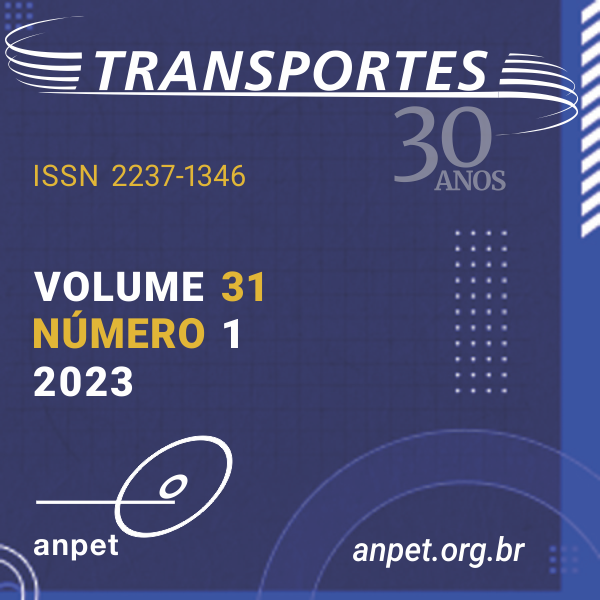Analysis of the feasibility of manufacturing concrete paving blocks with recycled aggregates from construction and demolition waste
DOI:
https://doi.org/10.58922/transportes.v31i1.2860Keywords:
Interlocking concrete blocks, Recycled aggregates, Construction and demolition waste, Design methodsAbstract
This paper aims to analyze the feasibility of using interlocking concrete blocks with recycled aggregates from construction and demolition waste for paving. First, dry concrete was produced, known to have zero slump, requiring a vibro-press machine for compaction and immediate stripping. Then, four dry concrete mixtures, CDW-0.63, REF-0.73, 50CDW-0.63, and 50CDW-0.73 (the first two and the last two without and with recycled aggregates, respectively), were applied with two water/cement ratios (0.63 and 0.73). In the next step, empirical and mechanistic-empirical design methods were used for interlocking block pavement, simulating the construction of this structure with cost evaluation. The results showed that the reference mixture REF-0.73, with more water, presented the highest characteristic compressive strength at 28 days (25.34 MPa). Furthermore, the interlocking pavement simulation from the mechanistic-empirical design, with recycled aggregates in the blocks (mixture 50CDW-0.63), generated savings of around US$76,000.00 compared to the pavement of reference blocks (mixture REF-0.73). Finally, dry concrete can present better mechanical behavior with the addition of water, and the interlocking pavement technology is more financially attractive applying the mechanistic-empirical design method.
Downloads
References
AASHTO (1995) Standard M 145: Specification for Classification of Soils and Soil-Aggregate Mixtures for Highway Construction Purposes. Washington, D.C.: American Association of State Highway and Transportation Officials.
ABNT (2004) Standard NBR 10004: Solid waste – Classification. Rio de Janeiro: Brazilian Technical Standards Association.
ABNT (2005) Standard NBR 9778: Hardened mortar and concrete – Determination of absorption, voids and specific gravity. Rio de Janeiro: Brazilian Technical Standards Association.
ABNT (2008) Standard NBR 9833: Fresh concrete – Determination of the unit weight, yield and air content by the gravimetric test method. Rio de Janeiro: Brazilian Technical Standards Association.
ABNT (2008) Standard NBR 15630: Mortars applied on walls and ceilings – Determination of elasticity modulus by the ultrasonic wave propagation. Rio de Janeiro: Brazilian Technical Standards Association.
ABNT (2011) Standard NBR 15953: Interlocking pavement with concrete units – Execution. Rio de Janeiro: Brazilian Technical Standards Association.
ABNT (2013) Standard NBR 9781: Concrete paving units – Specification and test methods. Rio de Janeiro: Brazilian Technical Standards Association.
ABNT (2017) Standard NBR 16605: Portland cement and other powdered material – Determination of the specific gravity. Rio de Janeiro: Brazilian Technical Standards Association.
ABNT (2021) Standard NBR 16916: Fine aggregate – Determination of density and water absorption. Rio de Janeiro: Brazilian Technical Standards Association.
ABNT (2021) Standard NBR 16917: Coarse aggregate - Determination of density and water absorption. Rio de Janeiro: Brazilian Technical Standards Association.
ABNT (2021) Standard NBR 16972: Aggregates – Determination of the unit weight and air-void contents. Rio de Janeiro: Brazilian Technical Standards Association.
ABNT (2022) Standard NBR 7211: Aggregates for concrete – Requirements. Rio de Janeiro: Brazilian Technical Standards Association.
ACI (2009) Standard 211.3R–02: Guide for Selecting Proportions for No-Slump Concrete. Farmington Hills: American Concrete Institute.
ASTM (2021) Standard C936: Specification for Solid Concrete Interlocking Paving Units. West Conshohocken: American Society for Testing and Materials.
Baird, C. and M. Cann (2011) Environmental chemistry (4th ed.). Porto Alegre: Bookman.
Carvalho, M. D. (1998) Technical Study 27: Paving with precast concrete units (4th ed.). Sao Paulo: Brazilian Portland Cement Association. Available at: <https://abcp.org.br/wp-content/uploads/2016/01/ET-27_Pavimentacao_pecas_premoldadas.pdf> (accessed on 25/01/2022).
Chu, S. H.; C. S. Poon; C. S. Lam and L. Li. (2021) Effect of natural and recycled aggregate packing on properties of concrete blocks. Construction and Building Materials, v. 278, 122247. DOI: 10.1016/j.conbuildmat.2021.122247. DOI: https://doi.org/10.1016/j.conbuildmat.2021.122247
CMAA (2018) DesignPave v2.0 (Version 2.0). Concrete Masonry Association of Australia. Available at: <https://www.cmaa.com.au/DesignPave/Registration> (accessed on 10/02/2022).
Crispim, M. (2018) Entulho volta a ser material de construção [Online]. Available at: <http://agenciaeconordeste.com.br/entulho-volta-a-ser-material-de-construcao/> (accessed on 18/04/2022).
Cruz, L. O. M. (2003) Interlocking Concrete Pavement: Study of Design Elements and Methods. M.Sc. Thesis. Federal University of Rio de Janeiro, Rio de Janeiro. Available at: <http://www.coc.ufrj.br/pt/dissertacoes-de-mestrado/103-msc-pt-2003/1840-luiz-otavio-maia-cruz> (accessed on 20/01/2022).
DNER (1994) Standard DNER–ME 180/94: Soils stabilized with fly ash and hydrated lime – Determination of the simple compressive strength. Brasilia, DF: National Highway Department.
DNIT (2016) Standard DNIT 172/2016–ME: Soils – Determination of the California Bearing Ratio using unworked samples – Test method. Brasilia, DF: National Transport Infrastructure Department.
DNIT (2018) Standard DNIT 134/2018–ME: Pavement – Soils – Determination of the resilient modulus – Test method. Brasilia, DF: National Transport Infrastructure Department.
Francisco, J. T. M.; A. E. Souza and S. R. Teixeira (2019) Construction and demolition waste in concrete: property of pre-molded parts for paving. Cerâmica, v. 65, suppl. 1, p. 22–26. DOI: 10.1590/0366-6913201965S12595. DOI: https://doi.org/10.1590/0366-6913201965s12595
Helene, P. and P. Terzian (1992) Concrete Dosage and Control Manual (1st ed.). Sao Paulo: Pini.
Lilley, A. A. and B. J. Walker (1986) Concrete block paving for heavily trafficked roads and paved areas (5th ed.). London: Cement and Concrete Association.
Luo, W.; S. Liu; Y. Hu; D. Hu; K.W. Kow; C. Pang and B. Li (2022) Sustainable reuse of excavated soil and recycled concrete aggregate in manufacturing concrete blocks. Construction and Building Materials, v. 342, 127917. DOI: 10.1016/j.conbuildmat.2022.127917. DOI: https://doi.org/10.1016/j.conbuildmat.2022.127917
Odemark, N. (1949) Investigations as to the Elastic Properties of Soils and Design of Pavements according to the Theory of Elasticity. Ph.D. Thesis. Statens Vagins Institute, Stockholm. Available at: <http://vti.diva-portal.org/smash/record.jsf?pid=diva2%3A867287&dswid=-1641> (accessed on 11/06/2022).
Ono, B. W.; J. T. Balbo and A. Cargnin (2017) Analysis of the infiltration capacity of unidirectionally jointed concrete block permeable pavement. Transportes, v. 25, n. 3, p. 90–101. DOI: 10.14295/transportes.v25i3.1314. DOI: https://doi.org/10.14295/transportes.v25i3.1314
Özalp, F.; H.D. Yılmaz, M. Kara, Ö. Kaya and A. Şahin (2016) Effects of recycled aggregates from construction and demolition wastes on mechanical and permeability properties of paving stone, kerb and concrete pipes, Construction and Building Materials, v. 110, p. 17–23. DOI: 10.1016/j.conbuildmat.2016.01.030. DOI: https://doi.org/10.1016/j.conbuildmat.2016.01.030
PMSP (2004) Project Instruction 06: Design of pavements with interlocking concrete blocks. Sao Paulo: Sao Paulo City Hall.
Poon, C.S. and D. Chan (2007) Effects of contaminants on the properties of concrete paving blocks prepared with recycled concrete aggregates, Construction and Building Materials, v. 21, n. 1, p. 164–175. DOI: https://doi.org/10.1016/j.conbuildmat.2005.06.031. DOI: https://doi.org/10.1016/j.conbuildmat.2005.06.031
SA (2003) Standard AS/NZS 4456.4: Masonry units and segmental pavers and flags – Methods of test – Determining compressive strength of masonry units. Sydney: Standards Australia.
SEINFRA-CE (2022) Table 027 (without tax). Fortaleza: Secretary of Infrastructure of Ceara. Available at: <https://www.seinfra.ce.gov.br/tabela-de-custos/> (accessed on 22/08/2022).
Shackel, B. (1988) The evolution and application of mechanistic design procedures for concrete block pavements. Proceedings of the III International Conference on Concrete Block Pavement. Rome: SEPT, p. 114–120. Available at:<http://www.sept.org/techpapers/108.pdf> (accessed on 20/01/2022).
Silva, W. B. C. (2020) Analysis of the feasibility of manufacturing interlocking concrete pavement blocks with the use of thermoelectric waste and recycled aggregate from civil construction. M.Sc. Thesis. Federal University of Ceara, Fortaleza. Available at: <https://repositorio.ufc.br/handle/riufc/56811> (accessed on 20/01/2020).
Vasconcelos, S. D. (2016) Evaluation of the heterogeneity of coal ash from the Energia Pecém thermoelectric power plant and its application in pavement granular layers. Monograph. Federal University of Ceara, Fortaleza. Available at: <https://repositorio.ufc.br/handle/riufc/47005> (accessed on 22/08/2022).
Vasconcelos, S. D.; S. H. A. Barroso; F. A. F. Vieira and H. B. F. Almeida (2019) Evaluation of the use of coal ash produced at a thermal power plant in pavement construction. Transportes, v. 27, n. 2, p. 73–89. DOI: 10.14295/transportes.v27i2.1592. DOI: https://doi.org/10.14295/transportes.v27i2.1592
Downloads
Published
How to Cite
Issue
Section
License
Copyright (c) 2023 Webert Brasil Cirilo da Silva, Suelly Helena de Araújo Barroso, Antônio Eduardo Bezerra Cabral, Ronaldo Stefanutti, Luís Guilherme de Picado-Santos

This work is licensed under a Creative Commons Attribution 4.0 International License.
Authors who submit papers for publication by TRANSPORTES agree to the following terms:
- Authors retain copyright and grant TRANSPORTES the right of first publication with the work simultaneously licensed under a Creative Commons Attribution License that allows others to share the work with an acknowledgement of the work's authorship and initial publication in this journal.
- Authors may enter into separate, additional contractual arrangements for the non-exclusive distribution of this journal's published version of the work (e.g., post it to an institutional repository or publish it in a book), with an acknowledgement of its initial publication in TRANSPORTES.
- Authors are allowed and encouraged to post their work online (e.g., in institutional repositories or on their website) after publication of the article. Authors are encouraged to use links to TRANSPORTES (e.g., DOIs or direct links) when posting the article online, as TRANSPORTES is freely available to all readers.
- Authors have secured all necessary clearances and written permissions to published the work and grant copyright under the terms of this agreement. Furthermore, the authors assume full responsibility for any copyright infringements related to the article, exonerating ANPET and TRANSPORTES of any responsibility regarding copyright infringement.
- Authors assume full responsibility for the contents of the article submitted for review, including all necessary clearances for divulgation of data and results, exonerating ANPET and TRANSPORTES of any responsibility regarding to this aspect.









